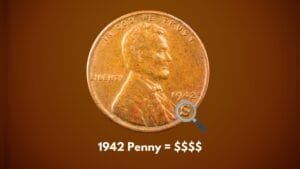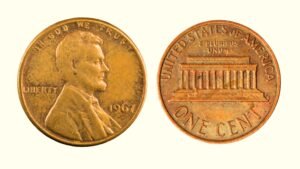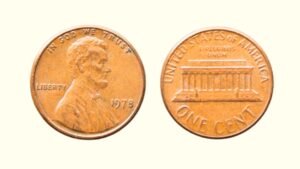Imagine stumbling upon a penny worth more than your favorite coffee! The 1957 Lincoln Wheat penny, which seems like a common copper coin, is a special coin for collectors. While most 1957 pennies might be worth only a cent or two, some rare varieties can fetch thousands of dollars at auction, like an example that fetched almost $30,000!
So, if you have a 1957 Wheat Penny in your collection, take it out, and let’s assess its worth! From analyzing its condition to looking for rare errors, this price guide will show you how to spot a valuable 1957 penny worth the money!
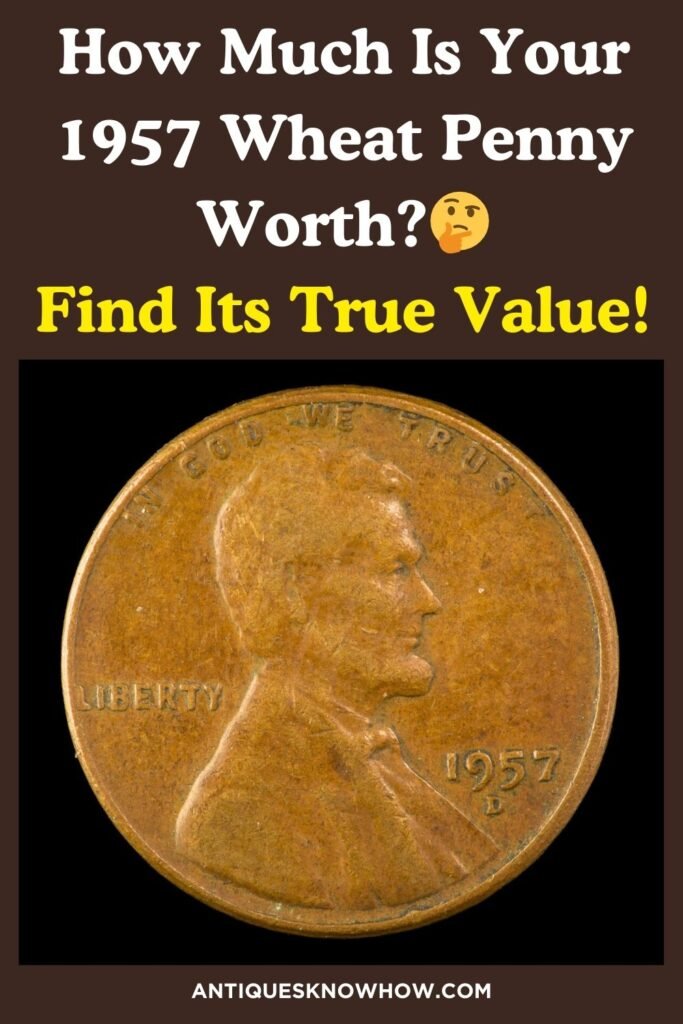
Brief History of 1957 Wheat Penny
The 1957 Lincoln Cent is a significant part of the Wheat Reverse Penny series introduced in 1909 to commemorate the 100th anniversary of Abraham Lincoln’s birth. By 1957, the coin had become a well-established and popular coinage staple with several changes.
In 1957, the U.S. Mint produced over 1 billion wheat pennies, reflecting their popularity. This 1957 penny is particularly notable for its mint marks, which indicate where the coin was produced: Philadelphia (no mint mark), Denver (D), and San Francisco (S).
Besides, the 1957 penny is one of the last Lincoln pennies with the wheat reverse, as the reverse design was replaced by Gilroy Roberts’ new Lincoln Memorial design, making them more sought after by coin collectors today!
| 1957 Lincoln Wheat Cent | Key Features & Facts |
| Coin Composition | 95% Copper, 5% Tin and Zinc |
| Minting Location | Philadelphia, Denver |
| Minting Year | 1957 |
| Face Value | 1-cent (0.01$) |
| Weight | 3.11 grams |
| Diameter | 19.05 mm |
| Thickness | 1.52 mm |
| Designer | Victor David Brenner |
| Mint Marks | D – Denver Mint, No Mint Mark – Philadelphia Mint |
| Total Mintage | 1,335,129,952 |
How to Identify a 1957 Wheat Cent by Design & Composition
Spotting a 1957 Lincoln penny, among other old coins, requires you to recognize its unique design elements on both sides and understand its composition and other physical characteristics.
1957 Lincoln Penny Obverse

- A right-facing profile of Abraham Lincoln
- The inscription “LIBERTY” to the left of Lincoln
- “IN GOD WE TRUST” inscription above Lincoln’s head
- The mint date “1957” located to the right of the portrait
- The designer’s initials “V.D.B.” for Victor David Brenner on Lincoln’s shoulder (may be difficult to see)
1957 Lincoln Penny Reverse
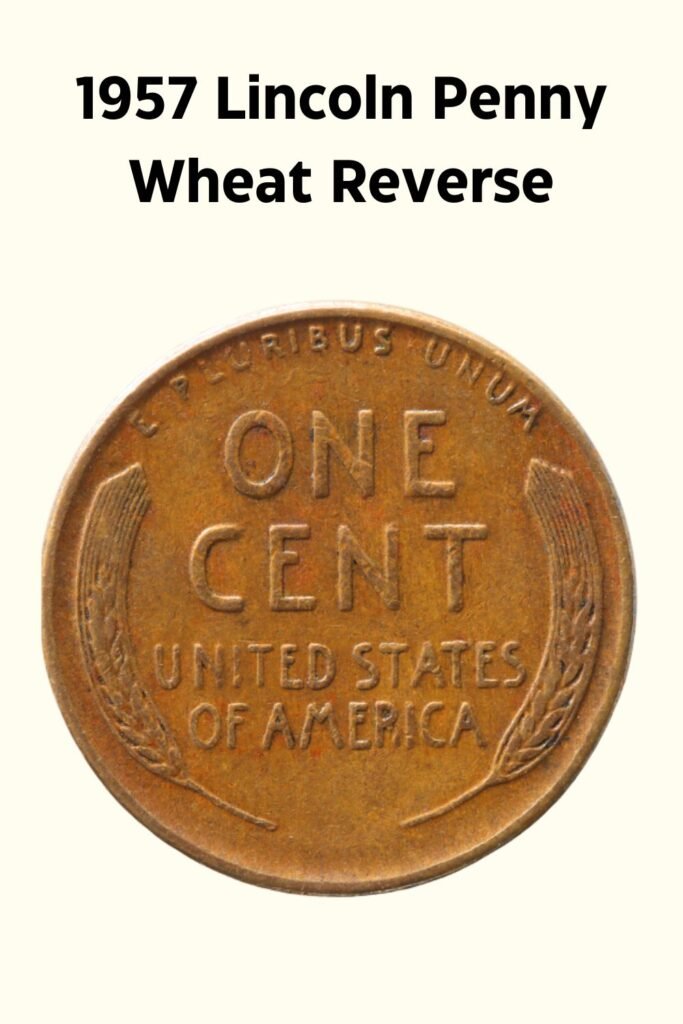
- Denomination “ONE CENT” at the center
- Two wheat stalks encircling the words “ONE CENT”
- “UNITED STATES OF AMERICA” along the top
- The words “E PLURIBUS UNUM” at the bottom.
Coin Composition, Size & Dimensions
The 1957 Lincoln Cent is composed of 95% copper and 5% zinc, making it a bronze coin. It has a diameter of 19 mm, a thickness of 1.52 mm, and weighs 2.5 grams. The coin has a smooth edge, which is an iconic characteristic of the wheat penny series.
Finding the Value of 1957 Lincoln Penny (5 Key Factors)
The average value of a 1957 Lincoln penny in the circulated condition is worth about $0.01 to $0.10. However, certain factors can significantly increase its value up to $20,000, including mint marks, condition, and rare mint errors. Let’s understand these factors in detail.
1. Coin Grading and Condition
The condition of a 1957 Lincoln Cent plays the most important role in determining its final value. Generally, coins are graded on a scale from PO-1 to MS-70, with higher grades indicating better condition.
1957 Wheat Pennies in uncirculated mint condition (MS-65+) are worth more than the circulated or almost circulated coins (AU-55+), with MS-67 examples reaching $10,000 or more.
2. Coin Toning & Color
The appearance (color) of a 1957 Wheat penny can vary significantly due to toning, which also impacts its worth. The three primary designations are:
- Red (RD): These pennies have a bright, red color, retaining up to 95% of their original luster, are the most valuable, and can command higher prices. Uncirculated wheat pennies graded RD can be worth $10 to $5,000 or more for higher grades.
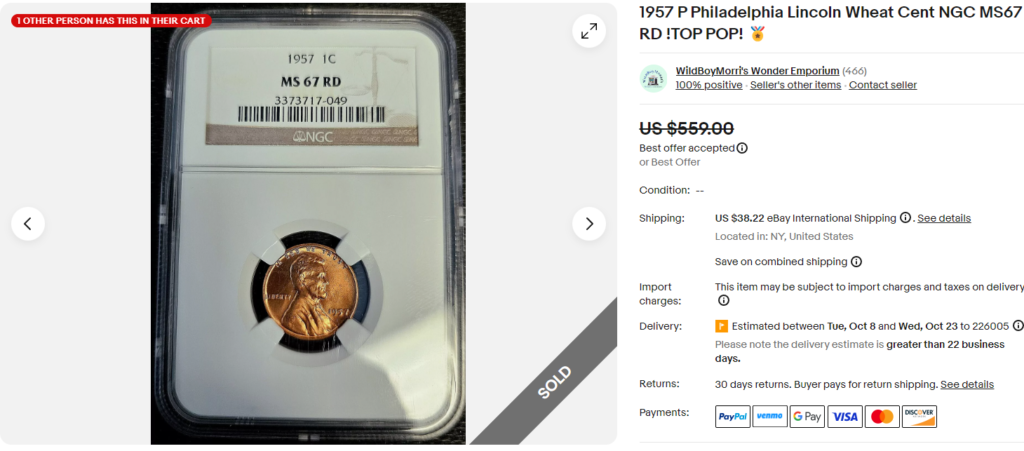
- Red-Brown (RB): These cents display a mix of red and brown hues, due to oxidation. They are less valuable than pure red coins but can still fetch a decent price, often around $5 to $15.
- Brown (BN): Brown pennies are those that have turned completely brown due to extreme oxidation. These coins are generally the least valuable, often worth only a few cents unless they have significant errors or high grades.
3. Mint Marks & Mintage
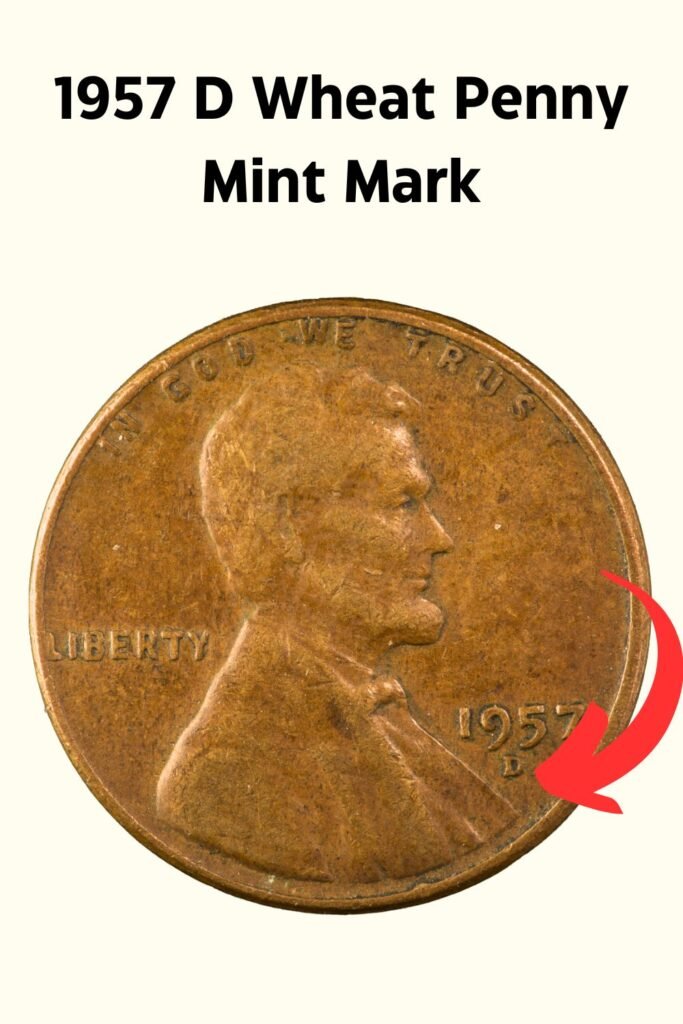
Generally, the higher the mintage, the more common and less valuable the coin. The 1957 Lincoln penny was minted at three different facilities, each with its mint mark and mintage, which can significantly impact its value.
- 1957 No Mint Mark Penny: Around 282,540,000 Wheat Pennies were minted at the Philadelphia Mint, identified by the no mint mark. In average condition, the 1957 no mint mark pennies are worth their face value of one cent, but uncirculated cents can reach up to $10 or more, while high-grade examples can fetch up to $1,000 or more!
- 1957 D Wheat Penny: The Denver Mint struck around 1,051,342,000 pennies in 1957, which bear the D mint mark. Like the Philadelphia cents, the 1957 D pennies are generally worth the face value in circulated condition, with uncirculated examples in common mint grades fetching up to $20 and higher grades up to $6,000 or more!
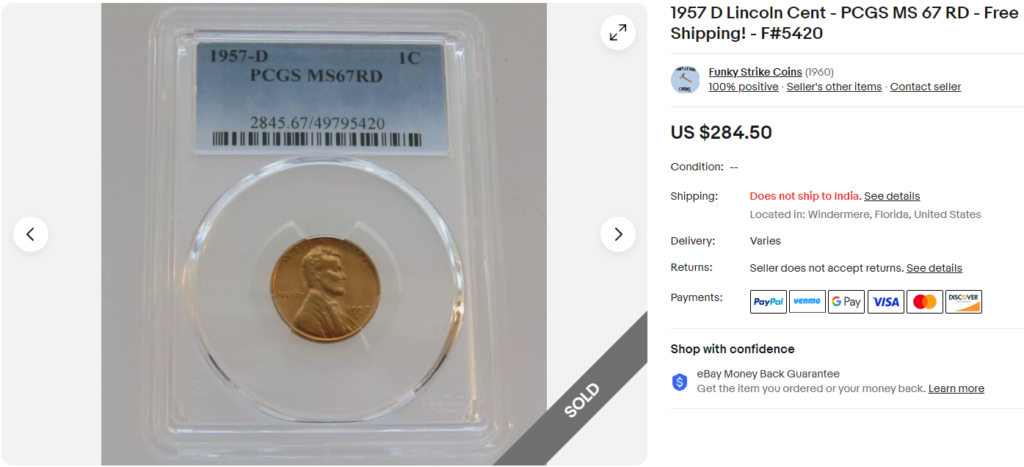
I’ve prepared this 1957 Lincoln Cent value chart based on coin grades and mint marks to easily assess a coin’s worth. (The average prices are for Red coins.)
| Coin Grades | Condition Details | 1957 No Mint Mark Penny Value | 1957 D Wheat Penny Value |
| Poor (0) to Extremely Fine (XF45) | Significant wear, faded but visible details | Face Value | Face Value |
| Almost Uncirculated (AU50) to Mint State (AU58+) | Slight wear on highest points, visible marks or blemishes | 20 cents to 50 cents | 10 cents to 30 cents |
| Mint State (MS60 – MS64) | Uncirculated with minimal wear | $3 – $15 | $2 – $10 |
| Mint State (MS65 – MS66+) | Nearly flawless with very minor imperfections | $15 – $150 | $15 – $40 |
| Mint State (MS67 – MS67+) | Well-preserved with no major flaws | $900 – $20,500+ | $200 – $6,600+ |
| Mint State (MS68 or Above) | Nearly perfect, luster, no major marks or flaws | N/A | N/A |
4. 1957 Lincoln Penny Proof Coins
Apart from the regular strikes, the United States Mint produced 1,247,952 proof 1957 Lincoln pennies at the Philadelphia Mint. Like the regular Philadelphia cents, these coins bear no mint mark. Specially minted for collectors, proof 1957 pennies feature a higher-quality finish, making them rarer.
The proof coins are also graded with three designations based on the design features:
- Regular Proof Coins: These proof coins feature a standard high-quality mirror-like surface. They are generally worth more than standard 1957 pennies, with values ranging from $5 to $30, depending on their PR grades.
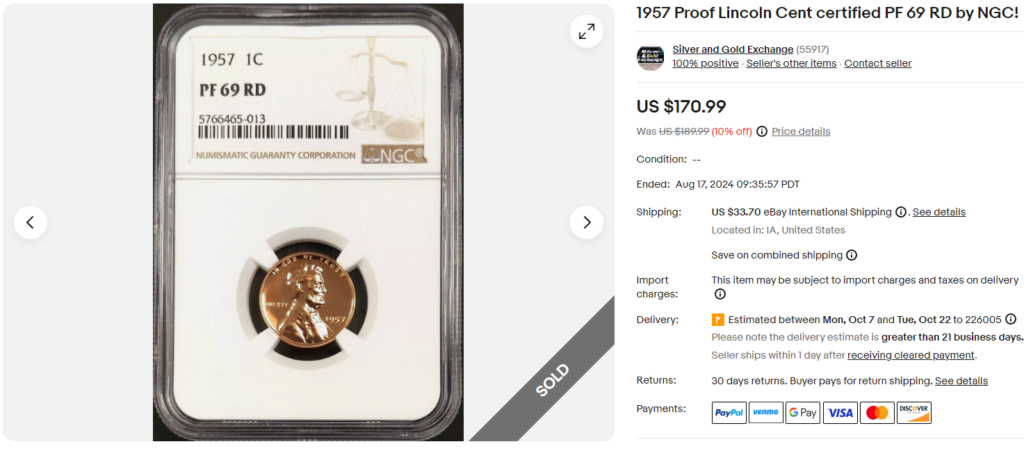
- Cameo Proofs (CAM): These 1957 proof pennies exhibit a contrast between the frosted design and the shiny background. These can be more valuable, with prices often exceeding $50 for well-graded examples.
- Deep Cameo Proofs (DCAM): Deep Cameo 1957 proof pennies feature the highest contrast between the mirror-like field and raised designs, making them the most sought- after. In the highest PR grades, like PR-68 or above, DCAM proofs can fetch up to $30,000, like this rare example that sold for $29,375 at Legend Rare Coin Auctions!
5. Rare 1957 Lincoln Penny Mint Errors List
Mint errors, or flaws that occur to a coin during the striking process, can greatly boost a 1957 Lincoln penny value. Look out for the following rare errors:
1957 D Penny Repunched Mintmark (RPM)
This error is a result of the mintmark (D, in the case of the 1957 Lincoln Penny) being struck multiple times, creating a blurry or doubled appearance. RPMs can increase a 1957 penny’s value to $50 or more, depending on the prominence of the error and the coin’s condition.
Off-Center Strike
This 1957 wheat penny error occurs when the coin planchet gets rotated in the die and is struck off-center, resulting in a missing portion of the design. 1957 pennies with minor off-center strikes are generally worth $50 to $200, with more dramatic off-center strikes fetching $500 or more.
Wrong Planchet Error
This rare error happens when a 1957 penny is mistakenly struck on a planchet meant for another denomination. The most popular and rare coin is the 1957 Wheat Penny struck on a Dime planchet, an AU-55 example sold for $646 on Heritage Auctions. Mint-state coins can fetch even more!
Another highly rare example of this error is a 1957 Lincoln Wheat Cent struck on a washer instead of a coin planchet. Featuring a hole at the center, this coin was sold for a stunning price of $7,475 on Heritage Auctions!
Double Die Obverse
This 1957 penny error occurs when a die featuring duplication of design elements strikes the coin, causing a doubling in the design elements. To spot this error, look for a doubling in the lettering of “LIBERTY” and the mint date “1957.” A 1957 penny with this error can be worth $10 to $100, depending on the condition.
5 Steps to Spot a Real or Fake 1957 Lincoln Penny
If you’re confused about whether your 1957 penny is genuine or not, follow these simple steps to find out:
- Check the Weight: Use a precise scale to weigh your coin. A genuine 1957 penny should weigh around 3.11 grams; any difference hints at a counterfeit.
- Measure the Dimensions: Measure your coin’s size precisely. If it does not match the standard thickness (1.52 mm) and diameter (19.05 mm), it could be a fake coin.
- Examine the Edge: The edge of a 1957 Lincoln penny must be plain. Look keenly for any unusual markings, reeding, or other irregularities.
- Look for Mint Marks: Verify the presence of the mint mark (if present). Make sure it’s located at the right place, which is below the year on obverse, and it matches known style and font for the 1957 cents.
- Check the Composition: Use a magnet to test your penny. If it reacts, it likely has a different composition than a 1957 penny’s bronze alloy.
Note: This article is intended for informational, educational, and entertainment purposes only. Some images are illustrative and may not represent actual brands, products, or related entities. All trademarks, product names, brand logos, packaging, and other intellectual property referenced remain the exclusive property of their respective owners. Any brand mentions or references are provided solely for descriptive and educational context and do not imply any formal or commercial association.



